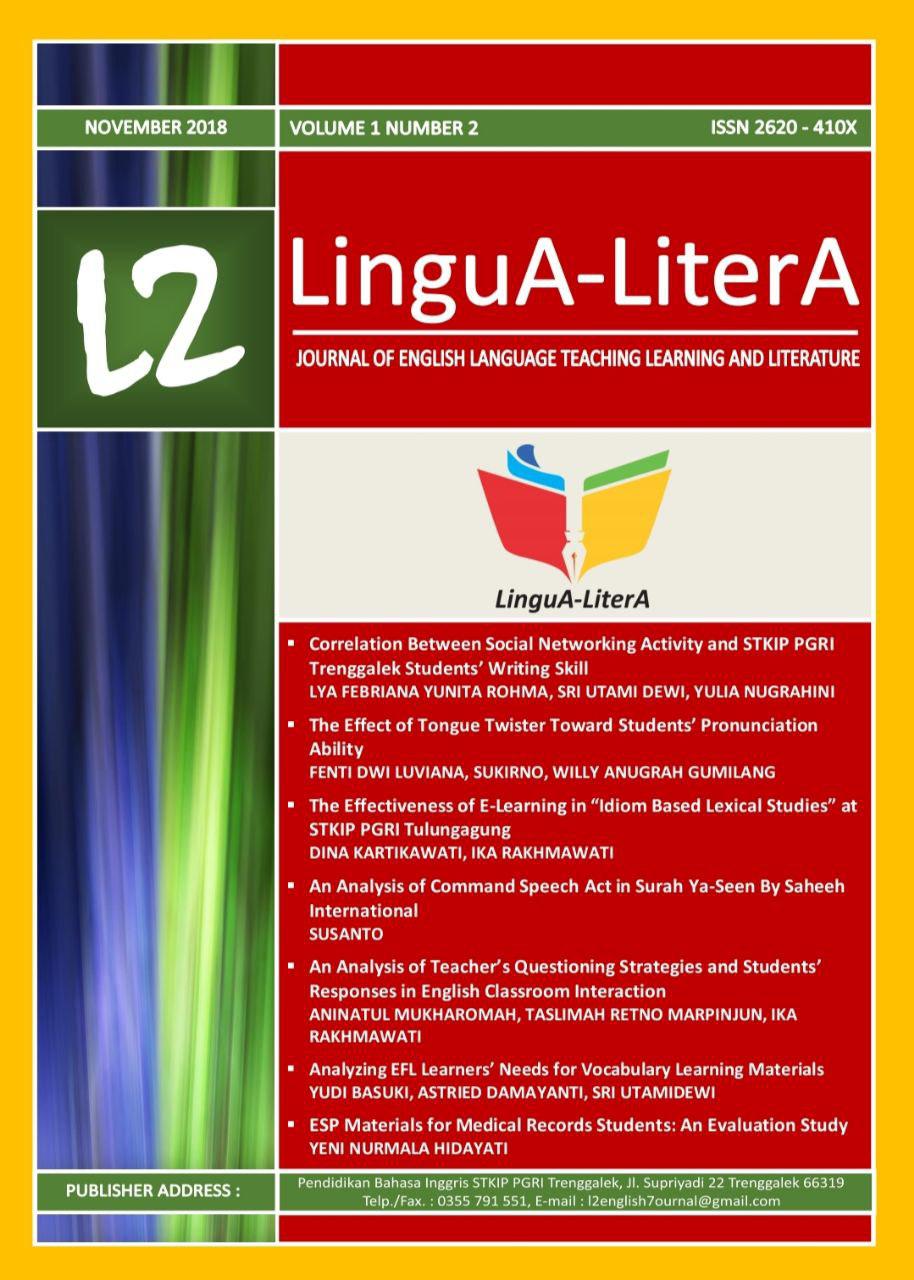Abstract
Having a fluent and a correct pronunciation when people are speaking English is the aim of designing this research. The lack of the awareness about how the importance of teaching pronunciation during the teaching-learning process makes the researcher encourages to do the research by applying one technique that is considered to improve students' pronunciation ability, namely tongue twisters. This technique is also chosen because it is fun and interesting. This research was carried out with a pre-experimental design that consisted of three stages applied to students of SMP Global Karangan as the subject of this research. The first stage, the researcher assessed the ability of students to pronounce the words through a pre-test. The second stage, the researcher treated the students where students got the knowledge about tongue twister. The third stage, students were given a post-test to reassess the pronunciation ability and were compared with the results of the pre-test before to find out the level of difference before and after getting treatment. After getting the results, the researcher proceeded to the analysis stage which was carried out the quantitative method which was using SPSS. The results of the analysis showed that there was an effect of tongue twister toward students' pronunciation ability
References
Akyuz, Manolya. (2016). Adapting Coursebook with Tongue Twisters in Foreign Language Classes of 4th Grades in Turkish Primary Schools in Order to Improve the Speaking Skills of Students. http://www.inciss.com/wp-content/uploads/2018/01/zpMANOLYA-AKY%C3%9CZ.pdf
Arikunto, S. (2010). Prosedur Penelitian Suatu Pendekatan Praktik. Jakarta: RinekaCipta.
Arikunto, S. (2013). Prosedur Penelitian Suatu Pendekatan Praktik. Jakarta: RinekaCipta.
Arjomad, Mehrnaz., MA. (2015). The Effect of Listening to Music on the Pronunciation of Lower Intermediate Iranian EFL Learners. http://www.ijern.com/journal/2015/March-2015/09.pdf
Ary, Donald., Jacobs, Lucy Cheser., Sorensen, Chris., & Razavieh, Asghar. (2010). Introduction to Research in Education. Eighth Edition. USA: Wadsworth Cengage Learning. https://www.amazon.com/Introduction-Research-Education-Donald-Ary
Basuki, Yudi. (2016). The Use of Peer-Assessment of Reading Aloud To Improve The
English Department Students’ motivation on Pronunciation Class of STKIP PGRI Trenggalek. Jurnal Pendidikan Dewantara. Vol 2 No. 1 (2016), (Online: http://journal.stkippgritrenggalek.ac.id/index.php/kid/article/view/52)
Basuki, Yudi. (2018). The Use of Drilling Method in Teaching Phonetic Transcription and Word Stress of Pronunciation Class. Jurnal LinguA-LiterA. Vol 1 No. 1 (2018), (Online: http://journal.stkippgritrenggalek.ac.id/index.php/kid/article/view/115/67)
Burns, A. & Claire, S. (2003). Clearly Speaking. Sydney: AMEP Research Centre Macquarie University.
Creswell, J.W. (2012). Educational Research Planning, Conducting, and Evaluating Quantitative and Qualitative Research (4th Ed). UK: Pearson Education.
Gilakjani, A. P. (2011). A Study on the Situation of Pronunciation Instruction in ESL/EFL Classrooms. Journal of Studies in Education. http://www.macrothink.org/journal/index.php/jse/article/view/924
Hamann, Cornelia. & Schmitz, Carmen., (2005). Phonetic and Phonology. University of Oldenburg https://www.scribd.com/document/367377748/Testovani-Ve-Vyuce-Cizich-Jazyku-b
Kelly, Gerald. (2000). Teach Pronunciation. UK: Bluestone Press, Charlbury, Oxfordshire. https://kupdf.com/download/gerald-kelly-how-to-teach-pronunciation-book-org_58cabf51dc0d607a3a339028_pdf
Kenworthy, Joanne. (1998). Teaching English Pronunciation. British: British Library Cataloguing. https://www.amazon.com/Teaching-Pronunciation-Handbooks-Language-Teachers/dp/0582746213
Korolkova, Yana V., Slabukho, Olesia A., Vydrina, Vera V., Zheleznyakova Anna N., & Zhang, Liyan (2015). Effective Technique for Working with the Tongue Twister in the Elementary Level of Training Russian as a Foreign Language. https://ac.els-cdn.com/S1877042815059364/1-s2.0-S1877042815059364-main.pdf?
Laszlo, Szilagyi. (2014). Put English Phonetics into Practice. http://genius-ja.uz.ua/sites/default/files/csatolmanyok/magyar-a-nyertesek-dokumentumai-725/book-englishphonetics.pdf
Machackova, B. E. (2012). Teaching English Pronunciation to Secondary School Students with Focus on “th” Consonants. A Diploma Thesis of Department of English Language and Literature Masaryk University Brno: Unpublish.
Putra et al. (2013). An Analysis of the Process of Teaching Pronunciation through Song. http://jurnal.fkip.unila.ac.id/index.php/123/article/view/8243
Sitoresmi, Ulupi. (2016). Tongue Twister in Pronunciation Class. E-Journal FKIP – UNS. http://www.jurnal.fkip.uns.ac.id/index.php/ictte/article/view/7673
Turumi, Yolllanda L., Jamiliddin, Salehuddin. (2014). Using Tongue Twister to Improve the Pronunciation of Grade VIII Students. E-journal of English Language Teaching Society (ELTS) Vol. 4 No. 2 2016 – ISSN 2331-1481. http://download.portalgaruda.org/article.php?article
Wardhaugh, Ronald. (2006). An Introduction to Sociolinguistics. UK: UK Copyright, Designs, and Patents Act 1988. https://www.amazon.com/Introduction-Sociolinguistics-Ronald-Wardhaugh/dp/1405186682

This work is licensed under a Creative Commons Attribution-ShareAlike 4.0 International License.
Copyright (c) 2018 Fenti Dwi Luviana, Sukirno, Willy Anugrah Gumilang

